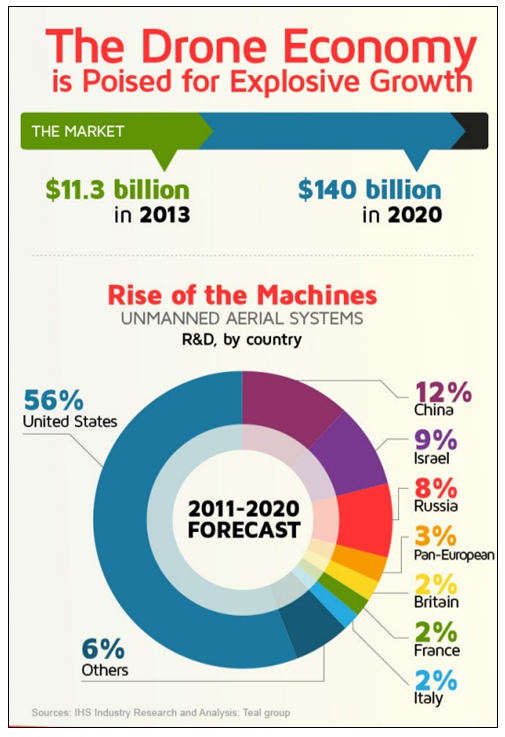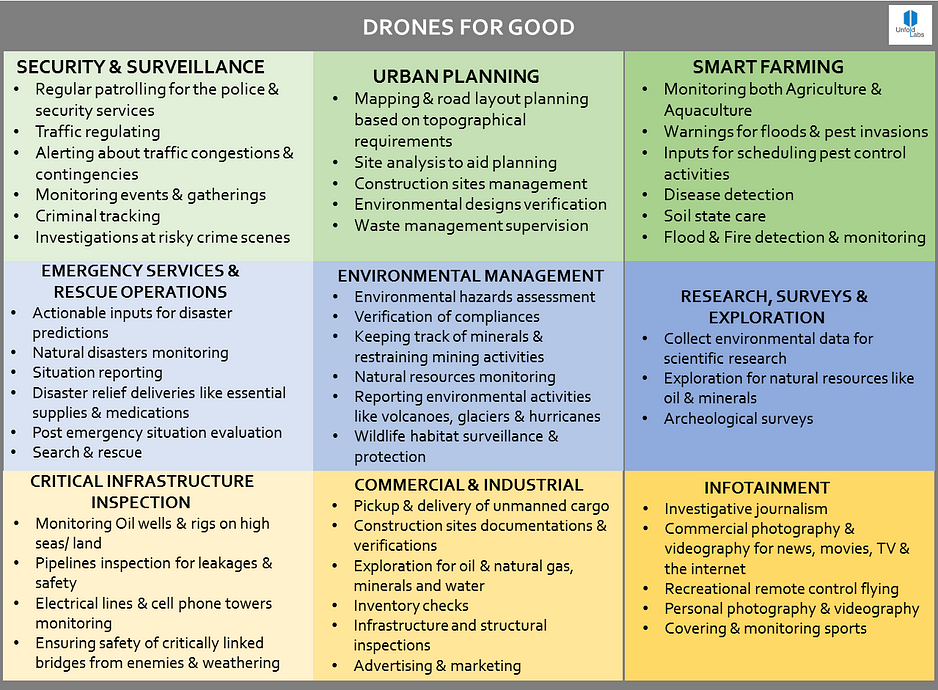Unfolding Drones — the Tech Toy that is here to STAY

The Drone Revolution — Killers? Surveyors? Toys?
Used predominately for precision attacks, unmanned combats, surveillance and for reconnaissance photography by the defense industry, drones were used discretely and intelligently. Today, drones are a mature technology. With drones becoming more affordable and practical, they offer interesting civilian uses. With the convergence of technologies in the Internet of Things (IoT), drones are set to merge seamlessly into solutions in the near term.
A couple of years ago, Amazon CEO Jeff Bezos shared the vision of the e-commerce giant to integrate commercial Drones into their delivery system. Known as Amazon Prime Air, it threw the drone technology into a completely different light. Google (Project Wing), Facebook, Walmart and many others were quick to follow Amazon and announce their projects to showcase that they were leaders in the industry as well. These companies are leading drones into the league of contemporary & promising technologies with their judicious investments.
Drones Flying In

Statistics and projections indicate interesting trends pointing to the increase in investments in drones across domains & industries throughout the world. Innovators of commercial drones who began their groundwork years ago, are set to make the most of the FAA announcement in the USA for the very first set of rules for commercial drones in 2016.
Drones - the Pioneers

Drones Flying High — The Good, The Bad, The Ugly
Available in varying sizes and abilities, drones can be as easy as the ones controlled by phones and tablets or as sophisticated as the ones almost the size of an airplane. With drones becoming simple to procure and use, a drone could be used for various intents..

Drones present a long list of technology put to use in sensible ways, the most common being its use in military and to combat terrorism. Drones are expected to become an indispensable part of the Internet of Things — catering to smart cities & smart farming, in supporting critical infrastructure, commercial applications, and aiding in scientific researcher. Agricultural drones are being used to facilitate precision farming with features like crop scouting, irrigation inspection, precision spraying, field mapping & crop assessments in countries like the US, Canada, UK, Australia & France. Drones have also helped report environmental activities like volcanoes, glaciers and hurricanes, thereby providing early warning and life savers.
On the other hand, drones can turn into life threatening hazards when they fly too close to airports or breach pre-defined air spaces. A growing number of accidents are now being reported and drones could soon turn into a menace or be perceived as a threat. There is a general worry that drones in the wrong hands can be used for illegal activities such as drug trafficking, spying and other attacks.
Flying High & Safe?
Drones have given rise to concerns over security breaches and safety & privacy issues. This is a technology setting pace for a revolution of the skies, but a device intended for the good of many if put in the wrong hands can wreak havoc.
Drones are a potentially transformative technology in diverse fields such as agriculture, law enforcement, coastal security, military training, search and rescue, first responder medical support, critical infrastructure inspection and many others. — White house, February 2015
- Drones are not to be operated over people
- Tests & security checks for non-recreational remote pilots operating Drones
- Drones to be operated at least five miles away from the airports
- Different flying zones for manned and unmanned aircrafts defined as the areas in the sky
With this ensured physical safety, the next important thing is to make the data collection procedures and the data itself private and secure to make the economic opportunities arising from the Drones more acceptable. The White House has further guidelines for safeguarding the data collected:
Entities that plan to use unmanned aircraft systems to gather personal information should have plans in place for how they collect, use and protect personal information. Like basic safety precautions, privacy should be a building block of every flight plan and every unmanned aircraft system operation.
The FAA takes charge of the UAV registrations and assure compliances by all operators in the USA. Across the world, the respective Aviation regulatory bodies take charge of the situation and are responsible for safety & privacy issues arising with the use of this innovative technology.
Our Take
With projections of as high as 7 million drones by 2020, drone technology is set to become mainstream. The most recent news from New Zealand — Dominos in association with Flirtey, debuts its pizza delivery using Drones, makes this innovative technology more interesting each passing day.
However, as with any technology, comes accountability and the ability to draw the fine line between restriction and freedom for all, especially in a technology like the UAVs which can easily go astray or become a big security threat if not kept under proper check.
The Internet of Things integrates various technologies to offer comprehensive solutions to enterprises with different needs. Drones a practical technology, is all set to become the next big thing going beyond its image of a simple killer or surveyor.
The advantages offered outnumber the threats posed by this 'toy' technology and despite the fact that there could be threatening uses, a growing number of drones are registered every year to be leveraged across domains and industries.
. . .

